University of Oxford: DrAlve Case Study Analysis - Module 6 Report
VerifiedAdded on 2022/09/07
|5
|1048
|16
Report
AI Summary
This report analyzes the DrAlve case study, focusing on the equity method of investment and board of directors' selection. The report evaluates three proposed term sheets, comparing options for equity allocation, size of the stock option pool, dividends, and founder/employee vesting. The analysis recommends the second option for its balanced equity distribution and standardized stock option size. The report further justifies the selection of Ivan Slatovenska for the board position due to his extensive experience and relevant postgraduate qualifications, and suggests Julian Noble as a suitable independent director. The analysis uses the provided biographies and term sheets to provide informed recommendations, considering the trade-offs between different options to best serve the company's overall interests.
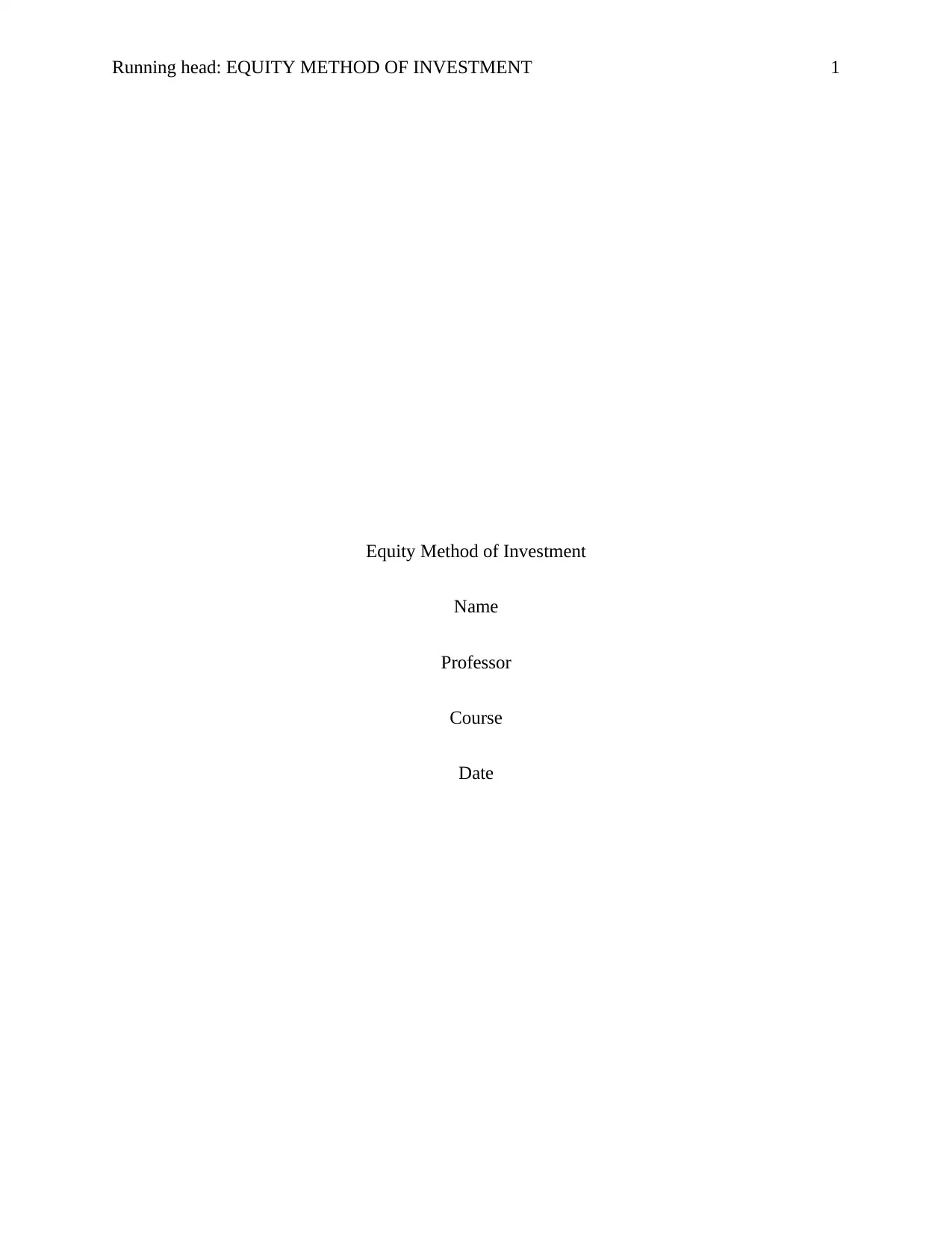
Running head: EQUITY METHOD OF INVESTMENT 1
Equity Method of Investment
Name
Professor
Course
Date
Equity Method of Investment
Name
Professor
Course
Date
Paraphrase This Document
Need a fresh take? Get an instant paraphrase of this document with our AI Paraphraser
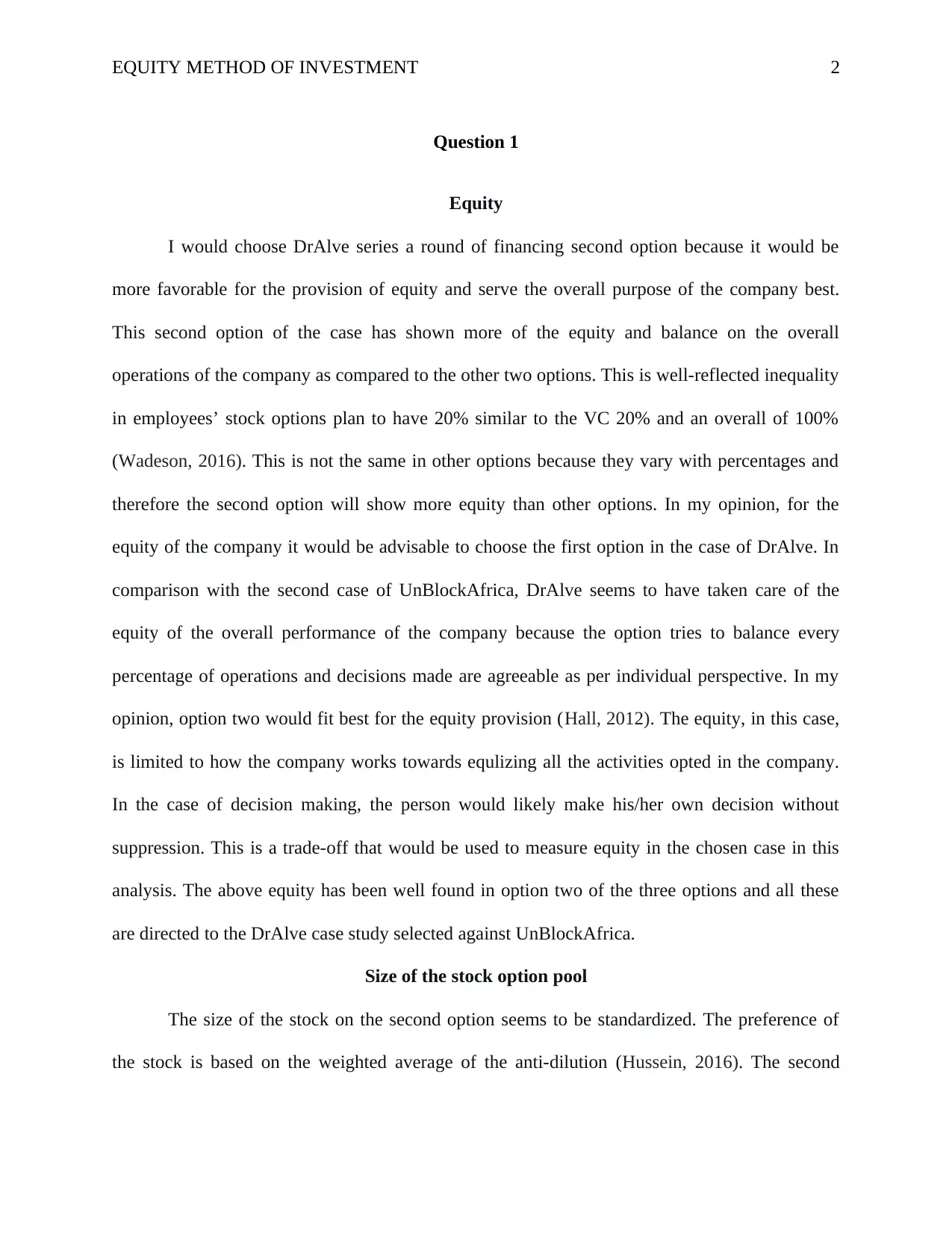
EQUITY METHOD OF INVESTMENT 2
Question 1
Equity
I would choose DrAlve series a round of financing second option because it would be
more favorable for the provision of equity and serve the overall purpose of the company best.
This second option of the case has shown more of the equity and balance on the overall
operations of the company as compared to the other two options. This is well-reflected inequality
in employees’ stock options plan to have 20% similar to the VC 20% and an overall of 100%
(Wadeson, 2016). This is not the same in other options because they vary with percentages and
therefore the second option will show more equity than other options. In my opinion, for the
equity of the company it would be advisable to choose the first option in the case of DrAlve. In
comparison with the second case of UnBlockAfrica, DrAlve seems to have taken care of the
equity of the overall performance of the company because the option tries to balance every
percentage of operations and decisions made are agreeable as per individual perspective. In my
opinion, option two would fit best for the equity provision (Hall, 2012). The equity, in this case,
is limited to how the company works towards equlizing all the activities opted in the company.
In the case of decision making, the person would likely make his/her own decision without
suppression. This is a trade-off that would be used to measure equity in the chosen case in this
analysis. The above equity has been well found in option two of the three options and all these
are directed to the DrAlve case study selected against UnBlockAfrica.
Size of the stock option pool
The size of the stock on the second option seems to be standardized. The preference of
the stock is based on the weighted average of the anti-dilution (Hussein, 2016). The second
Question 1
Equity
I would choose DrAlve series a round of financing second option because it would be
more favorable for the provision of equity and serve the overall purpose of the company best.
This second option of the case has shown more of the equity and balance on the overall
operations of the company as compared to the other two options. This is well-reflected inequality
in employees’ stock options plan to have 20% similar to the VC 20% and an overall of 100%
(Wadeson, 2016). This is not the same in other options because they vary with percentages and
therefore the second option will show more equity than other options. In my opinion, for the
equity of the company it would be advisable to choose the first option in the case of DrAlve. In
comparison with the second case of UnBlockAfrica, DrAlve seems to have taken care of the
equity of the overall performance of the company because the option tries to balance every
percentage of operations and decisions made are agreeable as per individual perspective. In my
opinion, option two would fit best for the equity provision (Hall, 2012). The equity, in this case,
is limited to how the company works towards equlizing all the activities opted in the company.
In the case of decision making, the person would likely make his/her own decision without
suppression. This is a trade-off that would be used to measure equity in the chosen case in this
analysis. The above equity has been well found in option two of the three options and all these
are directed to the DrAlve case study selected against UnBlockAfrica.
Size of the stock option pool
The size of the stock on the second option seems to be standardized. The preference of
the stock is based on the weighted average of the anti-dilution (Hussein, 2016). The second
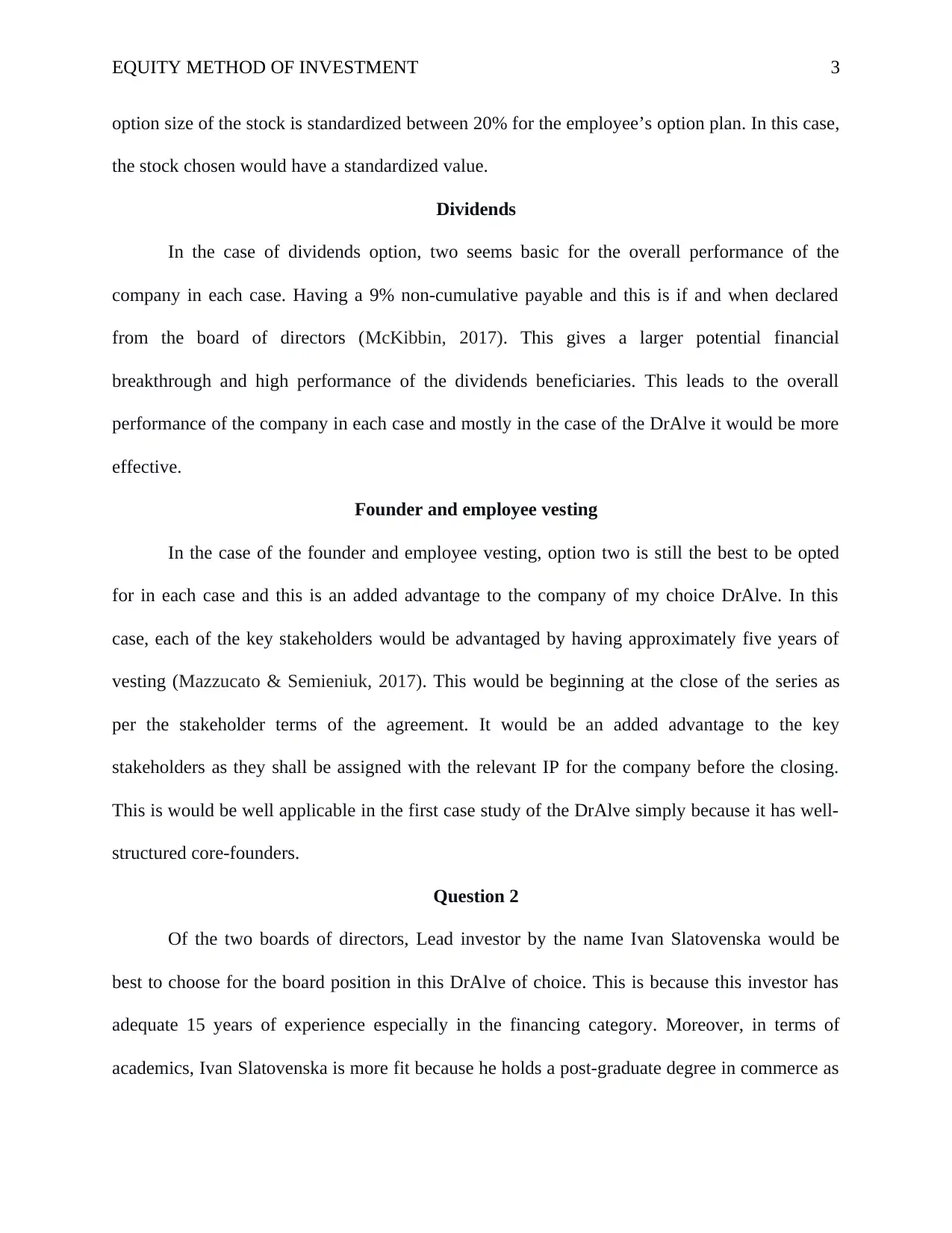
EQUITY METHOD OF INVESTMENT 3
option size of the stock is standardized between 20% for the employee’s option plan. In this case,
the stock chosen would have a standardized value.
Dividends
In the case of dividends option, two seems basic for the overall performance of the
company in each case. Having a 9% non-cumulative payable and this is if and when declared
from the board of directors (McKibbin, 2017). This gives a larger potential financial
breakthrough and high performance of the dividends beneficiaries. This leads to the overall
performance of the company in each case and mostly in the case of the DrAlve it would be more
effective.
Founder and employee vesting
In the case of the founder and employee vesting, option two is still the best to be opted
for in each case and this is an added advantage to the company of my choice DrAlve. In this
case, each of the key stakeholders would be advantaged by having approximately five years of
vesting (Mazzucato & Semieniuk, 2017). This would be beginning at the close of the series as
per the stakeholder terms of the agreement. It would be an added advantage to the key
stakeholders as they shall be assigned with the relevant IP for the company before the closing.
This is would be well applicable in the first case study of the DrAlve simply because it has well-
structured core-founders.
Question 2
Of the two boards of directors, Lead investor by the name Ivan Slatovenska would be
best to choose for the board position in this DrAlve of choice. This is because this investor has
adequate 15 years of experience especially in the financing category. Moreover, in terms of
academics, Ivan Slatovenska is more fit because he holds a post-graduate degree in commerce as
option size of the stock is standardized between 20% for the employee’s option plan. In this case,
the stock chosen would have a standardized value.
Dividends
In the case of dividends option, two seems basic for the overall performance of the
company in each case. Having a 9% non-cumulative payable and this is if and when declared
from the board of directors (McKibbin, 2017). This gives a larger potential financial
breakthrough and high performance of the dividends beneficiaries. This leads to the overall
performance of the company in each case and mostly in the case of the DrAlve it would be more
effective.
Founder and employee vesting
In the case of the founder and employee vesting, option two is still the best to be opted
for in each case and this is an added advantage to the company of my choice DrAlve. In this
case, each of the key stakeholders would be advantaged by having approximately five years of
vesting (Mazzucato & Semieniuk, 2017). This would be beginning at the close of the series as
per the stakeholder terms of the agreement. It would be an added advantage to the key
stakeholders as they shall be assigned with the relevant IP for the company before the closing.
This is would be well applicable in the first case study of the DrAlve simply because it has well-
structured core-founders.
Question 2
Of the two boards of directors, Lead investor by the name Ivan Slatovenska would be
best to choose for the board position in this DrAlve of choice. This is because this investor has
adequate 15 years of experience especially in the financing category. Moreover, in terms of
academics, Ivan Slatovenska is more fit because he holds a post-graduate degree in commerce as
⊘ This is a preview!⊘
Do you want full access?
Subscribe today to unlock all pages.

Trusted by 1+ million students worldwide
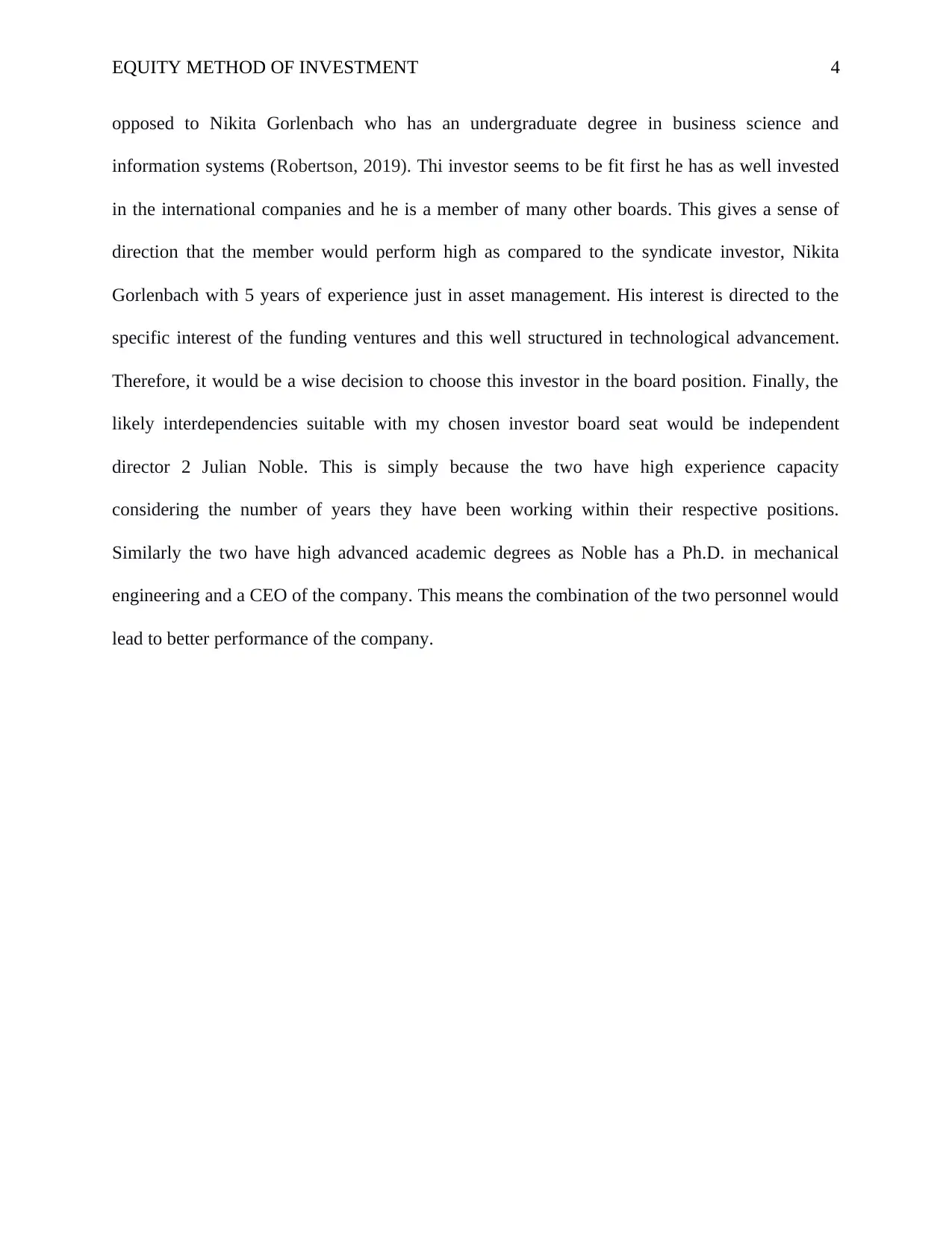
EQUITY METHOD OF INVESTMENT 4
opposed to Nikita Gorlenbach who has an undergraduate degree in business science and
information systems (Robertson, 2019). Thi investor seems to be fit first he has as well invested
in the international companies and he is a member of many other boards. This gives a sense of
direction that the member would perform high as compared to the syndicate investor, Nikita
Gorlenbach with 5 years of experience just in asset management. His interest is directed to the
specific interest of the funding ventures and this well structured in technological advancement.
Therefore, it would be a wise decision to choose this investor in the board position. Finally, the
likely interdependencies suitable with my chosen investor board seat would be independent
director 2 Julian Noble. This is simply because the two have high experience capacity
considering the number of years they have been working within their respective positions.
Similarly the two have high advanced academic degrees as Noble has a Ph.D. in mechanical
engineering and a CEO of the company. This means the combination of the two personnel would
lead to better performance of the company.
opposed to Nikita Gorlenbach who has an undergraduate degree in business science and
information systems (Robertson, 2019). Thi investor seems to be fit first he has as well invested
in the international companies and he is a member of many other boards. This gives a sense of
direction that the member would perform high as compared to the syndicate investor, Nikita
Gorlenbach with 5 years of experience just in asset management. His interest is directed to the
specific interest of the funding ventures and this well structured in technological advancement.
Therefore, it would be a wise decision to choose this investor in the board position. Finally, the
likely interdependencies suitable with my chosen investor board seat would be independent
director 2 Julian Noble. This is simply because the two have high experience capacity
considering the number of years they have been working within their respective positions.
Similarly the two have high advanced academic degrees as Noble has a Ph.D. in mechanical
engineering and a CEO of the company. This means the combination of the two personnel would
lead to better performance of the company.
Paraphrase This Document
Need a fresh take? Get an instant paraphrase of this document with our AI Paraphraser
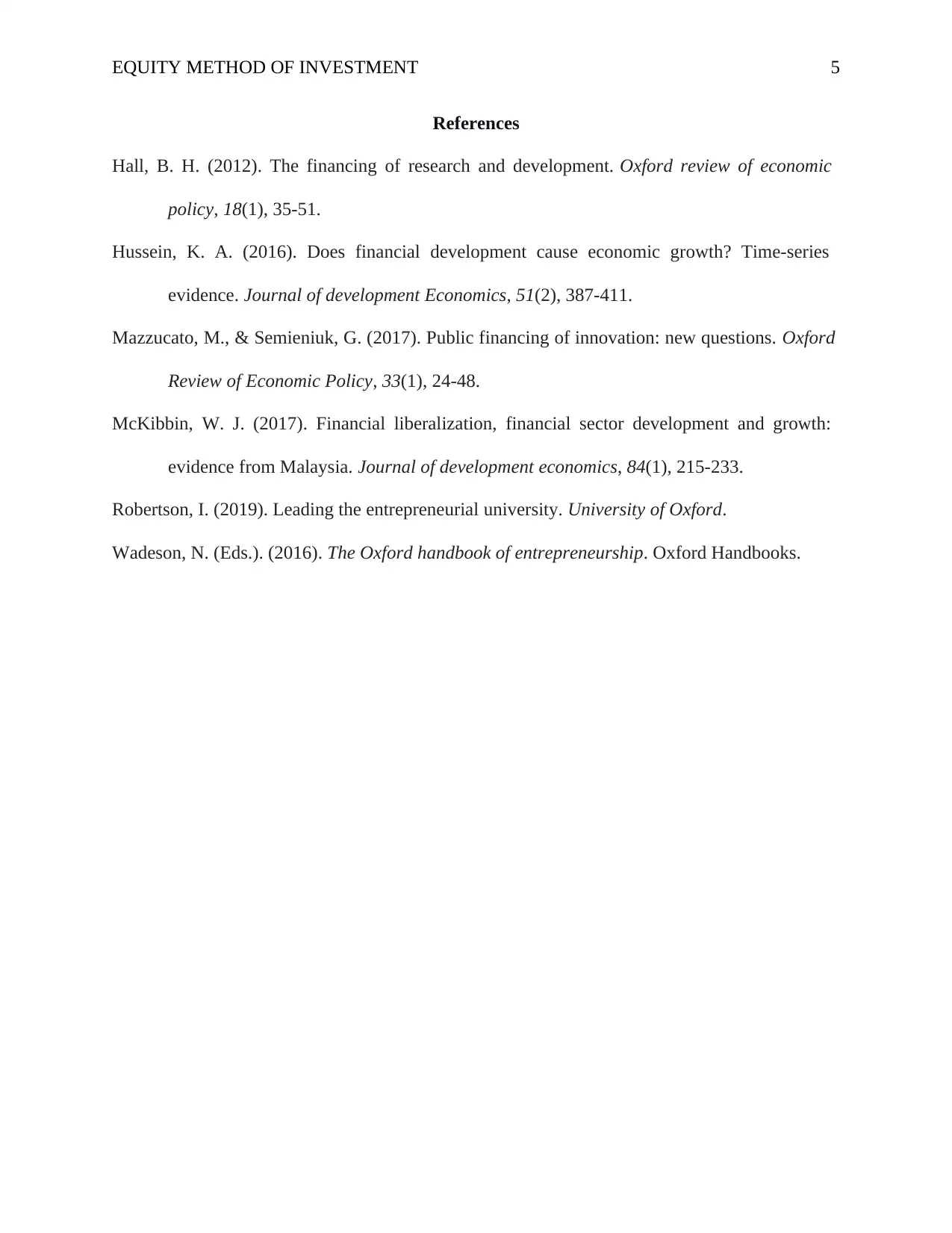
EQUITY METHOD OF INVESTMENT 5
References
Hall, B. H. (2012). The financing of research and development. Oxford review of economic
policy, 18(1), 35-51.
Hussein, K. A. (2016). Does financial development cause economic growth? Time-series
evidence. Journal of development Economics, 51(2), 387-411.
Mazzucato, M., & Semieniuk, G. (2017). Public financing of innovation: new questions. Oxford
Review of Economic Policy, 33(1), 24-48.
McKibbin, W. J. (2017). Financial liberalization, financial sector development and growth:
evidence from Malaysia. Journal of development economics, 84(1), 215-233.
Robertson, I. (2019). Leading the entrepreneurial university. University of Oxford.
Wadeson, N. (Eds.). (2016). The Oxford handbook of entrepreneurship. Oxford Handbooks.
References
Hall, B. H. (2012). The financing of research and development. Oxford review of economic
policy, 18(1), 35-51.
Hussein, K. A. (2016). Does financial development cause economic growth? Time-series
evidence. Journal of development Economics, 51(2), 387-411.
Mazzucato, M., & Semieniuk, G. (2017). Public financing of innovation: new questions. Oxford
Review of Economic Policy, 33(1), 24-48.
McKibbin, W. J. (2017). Financial liberalization, financial sector development and growth:
evidence from Malaysia. Journal of development economics, 84(1), 215-233.
Robertson, I. (2019). Leading the entrepreneurial university. University of Oxford.
Wadeson, N. (Eds.). (2016). The Oxford handbook of entrepreneurship. Oxford Handbooks.
1 out of 5
Your All-in-One AI-Powered Toolkit for Academic Success.
+13062052269
info@desklib.com
Available 24*7 on WhatsApp / Email
![[object Object]](/_next/static/media/star-bottom.7253800d.svg)
Unlock your academic potential
Copyright © 2020–2025 A2Z Services. All Rights Reserved. Developed and managed by ZUCOL.


